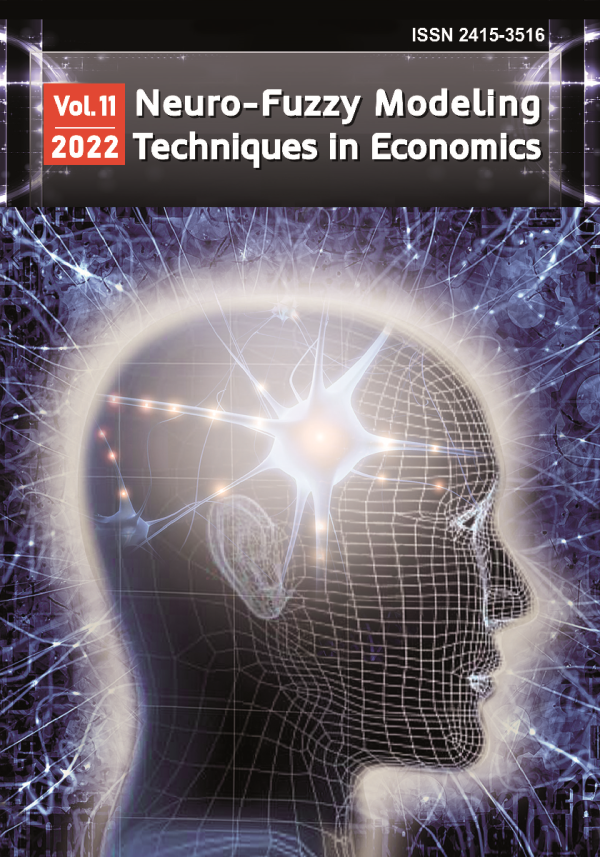
Neuro-Fuzzy Modeling Techniques in Economics
ПРОЦЕДУРА РЕЦЕНЗУВАННЯ
Кожна публікація оцінюється головним редактором, і якщо основні вимоги виконані, текст надсилається далі на рецензування. Кожна публікація оцінюється двома незалежними рецензентами. Принаймні один із рецензентів є представником іноземної установи, яка є відмінна від громадянства автора.
Застосовується процес подвійного сліпого рецензування , коли ні Автори, ні Рецензенти не знають один одного.
Етапи рецензування статті:
1. Автор надсилає рукопис на електронну пошту журналу. Рукопис направляється головному редактору або його заступнику, який визначає відповідність статті пріоритетним напрямам, етичним стандартам, перевіряє на наявність плагіату й аналізує якість наукового дослідження. Рукописи, що не відповідають тематиці та стандартам журналу, а також низької наукової якості відхиляються без передачі на рецензування. Автор отримує повідомлення, що його рукопис відхилено.
2. На наступному етапі вчений секретар перевіряє структуру статті, відповідність вимогам, повноту інформації. Якщо рукопис не відповідає вимогам, до автора звертаються з проханням внести зміни відповідно до вимог.
3. Рукопис, що відповідає всім вимогам журналу, передається на рецензування двом рецензентам. Вибір рецензентів для кожної статті визначається експертним рівнем, репутацією, конкретними рекомендаціями та попереднім досвідом. Автор отримує повідомлення, що його рукопис переданий на рецензування.
4. Рецензент зобов’язується дотримуватися етичних правил журналу та надати рецензію. Рішення про публікацію поданого рукопису приймається на підставі експертних висновків рецензентів та остаточно затверджується редколегією.
5. Стаття, яка отримала дві позитивні рецензії, включається до плану публікацій журналу зі статусом «прийнята». Автор отримує повідомлення про прийняття публікації до друку.
6. Якщо обидві рецензії є позитивними, але містять зауваження і коментарі рецензентів, автори отримують повідомлення про погодження до публікації за умови доопрацювання та анонімні зауваження рецензентів. Автори повинні врахувати рекомендації рецензентів та виправити виявлені помилки.
7. Якщо стаття отримує одну позитивну, а другу негативну рецензію, при цьому редакційна колегія вважає результати проведеного дослідження значущими, така стаття повертається авторам із зауваженнями для доопрацювання.
8. Якщо автори категорично не згодні з думкою рецензентів та відмовляються вносити правки до тексту статті, така стаття отримує статус «відхилена».
9. Якщо стаття отримує дві негативні рецензії, вона не приймається до публікації. Автор отримує повідомлення про те, що стаття відхилена без права повторної подачі.
10. Усі редакційні правки надсилаються для погодження та схвалення авторам. Остаточна версія зверстаної статті погоджується з авторами. Після узгодження, стаття набуває статусу «до публікації» та вноситься до плану публікацій журналу «Нейро-нечіткі технології моделювання в економіці».
THE PROCEDURE OF REVIEWING
Each publication is evaluated by editor-in-chief and if the basic requirements are fulfilled the text is sent to review. Each publication is evaluated by at least two independent Reviewers. At least one of the Reviewers is affiliated in a foreign institution, which is different than the Author’s nationality. The double-blind review process is applied, where neither the Authors nor the Reviewers know each other’s identities.
Stages of article review:
1. The author sends the manuscript to the e-mail of the journal. At the beginning, the manuscript is sent to the editor-in-chief or his deputy, who determines the compliance of the article with the priority areas, ethical standards, checks for plagiarism and analyzes the quality of scientific research. Manuscripts that do not meet the subject and standards of the journal, as well as low scientific quality are rejected without submission for review. The author receives a message that his manuscript has been rejected.
2. At the next stage, the scientific secretary checks the structure, compliance with the requirements for submission, completeness of information of the article. If the manuscript does not meet the requirements for submission, the author is asked to submit a complete package of documents.
3. A manuscript that meets all the requirements of the journal is submitted for review to two reviewers. The selection of reviewers for each article is determined by their level of expertise, reputation, specific recommendations and previous experience. The author receives a message that his manuscript has been submitted for review.
4. The reviewer undertakes to follow the publication ethics of the journal and provide a review. The decision to publish the submitted manuscript is made on the basis of expert opinions of reviewers and finally approved by the editorial board.
5. The article that has received two positive reviews is included in the publication plan of the journal with the status "accepted". The author receives a notification of acceptance of the publication for printing.
6. If both reviews are positive, but contain comments and comments of reviewers, the authors receive notification of approval for publication subject to revision and anonymous comments of reviewers. Authors should take into account the recommendations of reviewers and correct errors.
7. If the article receives one positive and the other negative review, and the editorial board considers the results of the study significant, such an article is returned to the authors with comments for revision.
8. If the authors strongly disagree with the opinion of the reviewers and refuse to make changes to the text of the article, such an article receives the status of "rejected".
9. If an article receives two negative reviews, it is not accepted for publication. The author is notified that the article has been rejected without the right to resubmit.
10. All editorial changes are sent for approval and approval by the authors. The final version of the article agrees with the authors. After approval, the original article acquire the status of "to publication" and are included in the publication plan of the journal "Neuro-Fuzzy Modeling Techniques in Economics".

